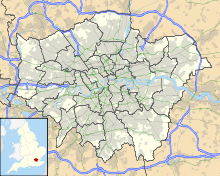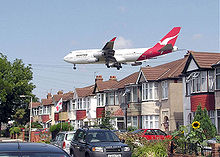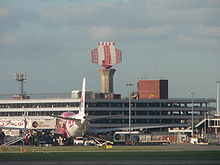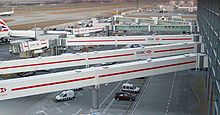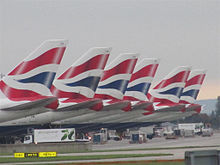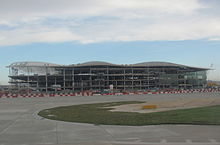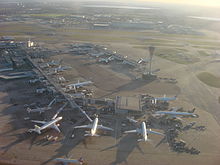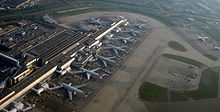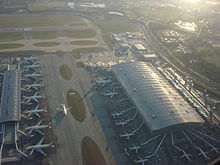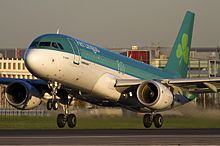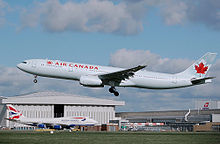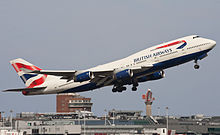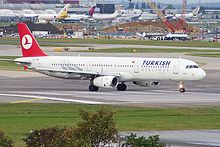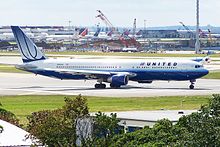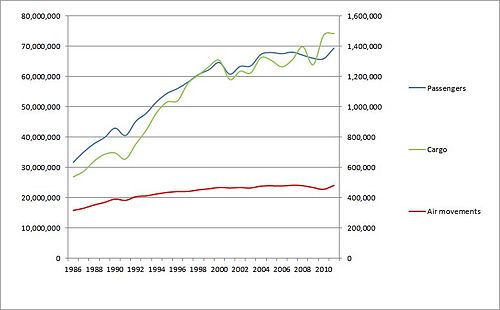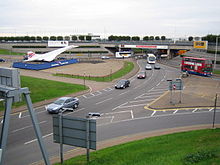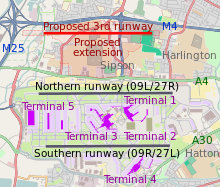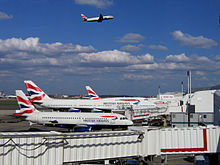
London Heathrow Airport
About this schools Wikipedia selection
SOS Children offer a complete download of this selection for schools for use on schools intranets. SOS Children is the world's largest charity giving orphaned and abandoned children the chance of family life.
| London Heathrow Airport | |||
|---|---|---|---|
| |
|||
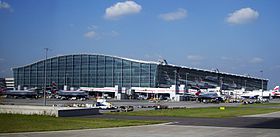 |
|||
| Heathrow Terminal 5 building | |||
| IATA: LHR – ICAO: EGLL – WMO: 03772 |
|||
| Summary | |||
| Airport type | Public | ||
| Owner | Heathrow Airport Holdings | ||
| Operator | Heathrow Airport Limited | ||
| Location | Hillingdon, London, United Kingdom | ||
| Hub for | |||
| Focus city for |
|
||
| Elevation AMSL | 83 ft / 25 m | ||
| Coordinates | 51°28′39″N 000°27′41″W Coordinates: 51°28′39″N 000°27′41″W | ||
| Website | |||
| Map | |||
| Location within Greater London | |||
| Runways | |||
| Direction | Length | Surface | |
| m | ft | ||
| 09L/27R | 3,901 | 12,799 | grooved asphalt |
| 09R/27L | 3,660 | 12,008 | grooved asphalt |
| Statistics (2012) | |||
| Passengers | 70,037,417 | ||
| Passenger change 11-12 | |||
| Aircraft movements | 475,176 | ||
| Movements change 11-12 | |||
| Sources: UK AIP at NATS and EUROCONTROL Statistics from the UK Civil Aviation Authority |
|||
London Heathrow Airport or Heathrow ( IATA: LHR, ICAO: EGLL) is a major international airport serving London, England, United Kingdom. Located in the London Borough of Hillingdon, in West London, Heathrow is the busiest airport in the United Kingdom and the third busiest airport in the world (as of 2012) in terms of total passenger traffic, handling more international passengers than any other airport around the globe. It is also the busiest airport in the EU by passenger traffic and the third busiest in Europe given the number of traffic movements, with a figure surpassed only by Paris-Charles de Gaulle Airport and Frankfurt Airport. Heathrow is London's main airport, having replaced RAF Northolt and the earlier and better-known Croydon Airport, and together with Gatwick, Southend, Stansted, Luton and London City, London is the busiest city airport system in the world by passenger traffic (with 133,666,888 passengers travelling through the six airports); and second only to New York City in terms of traffic movements. The airport sustains 76,600 jobs directly and around 116,000 indirectly in the immediate area, and this, together with the large number of global corporations with offices close to the airport, makes Heathrow a modern aerotropolis which contributes an estimated 2.7% to London's total GVA.
The airport is owned and operated by Heathrow Airport Holdings, which also owns and operates four other UK airports, and is itself owned by FGP TopCo Limited, an international consortium, which includes Caisse de dépôt et placement du Québec and GIC Special Investments, that is led by the Spanish Ferrovial Group. Heathrow is the primary hub for British Airways and the primary operating base for Virgin Atlantic Airways.
Heathrow lies 12 nautical miles (22 km; 14 mi) west of Central London, and has two parallel east–west runways along with four operational terminals on a site that covers 12.14 square kilometres (4.69 sq mi). Terminal 5 was officially dedicated by Queen Elizabeth II on 14 March 2008 and opened to passengers on 27 March 2008. Construction of a new Terminal 2 complex to replace the old terminal building and adjacent Queen's Building began in 2009 with the first phase expected to open in 2014. Terminals 3 and 4 underwent major refurbishments between 2007 and 2009. In November 2007, a consultation process began for the building of a new third runway and a sixth terminal, which was controversially approved on 15 January 2009 by UK Government ministers. The project was subsequently cancelled on 12 May 2010 by the Cameron Government.
The airport holds a Civil Aviation Authority Public Use Aerodrome Licence (Number P527), which allows flights for public transportation of passengers or for flying instruction.
Location
Heathrow is 14 mi (23 km) west of central London, near the south end of the London Borough of Hillingdon on a parcel of land that is designated part of the Metropolitan Green Belt. The airport is surrounded by the built-up areas of Harlington, Harmondsworth, Longford and Cranford to the north and by Hounslow and Hatton to the east. To the south lie Bedfont and Stanwell while to the west Heathrow is separated from Colnbrook in Berkshire by the M25 motorway.
As the airport is west of London and as its runways run east–west, an airliner's landing approach is usually directly over the conurbation of London. Other leading European airports, such as those at Madrid, Frankfurt and Paris, are located north or south of their respective cities to minimise the overflying problem.
Along with Biggin Hill, Gatwick, Stansted, Luton, Southend and City, Heathrow is one of seven airports serving the London area; although only Heathrow, Biggin Hill and City are within Greater London.
History
Heathrow Airport started in 1929 as a small airfield ( Great West Aerodrome) on land southeast of the hamlet of Heathrow (straddling a road which ran along the east and south edges of the present main terminals area). Development of the whole Heathrow area as a very big airfield started in 1944, stated to be for long-distance military aircraft bound for the far east. However, by the time the airfield was nearing completion, World War 2 had ended. The government continued to develop the airfield as a civil airport known as London Airport and later Heathrow.
The name 'Heathrow' originates from a local hamlet called 'Heathrow' or 'Heath Row', whose land was mostly farms and market gardens and orchards; there was a 'Heathrow Farm' (approximately where Terminal 1 is now), and a Heathrow Hall and a Heathrow House. Now the name 'Heathrow' is widely known across the world, and occurs in the names of many establishments around the airport, some having no connection with aviation, such as the Heathrow Garden Centre in Sipson.
Heathrow today
Heathrow Airport is used by over 90 airlines flying to 170 destinations worldwide. The airport is the primary hub of British Airways, and is a base for Virgin Atlantic Airways.
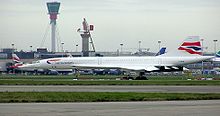
Of Heathrow's 69 million passengers in 2011, 7% were bound for UK destinations, 41% were short-haul international travellers and 52% were long-haul. The busiest single destination in terms of passenger numbers is New York, with over 3.8 million passengers travelling between Heathrow and JFK / Newark airports in 2011. The airport has four passenger terminals (Terminals 1, 3, 4 and 5) and a cargo terminal. The new passenger Terminal 2 is due to open in 2014, replacing the previous Terminal 2 facility.
In the 1950s, Heathrow had six runways, arranged in three pairs at different angles in the shape of a hexagram with the permanent passenger terminal in the centre and the older terminal along the north edge of the field, and two of its runways would always be within 30° of the wind direction. As the required length for runways has grown, Heathrow now has just two parallel runways running east–west. These are extended versions of the two east-west runways from the original hexagram. In a good quality birds-eye view, almost all of the original runways can still be plainly seen, incorporated into the present system of taxiways. All, that is, except for the northernmost point, which has been completely lifted to allow for the enlarged entrance to the access tunnel. The northern apex, of the six pointed star, lay precisely at the point now occupied by Heathrow's unofficial ' gate-guardian'. For many years the home of a 40% model of a British Airways Concorde, G-CONC, the site is now occupied by a model of an Emirates Airbus A380.
Policing of the airport is the responsibility of the aviation security unit of the Metropolitan Police, although the army, including armoured vehicles of the Household Cavalry, has occasionally been deployed at the airport during periods of heightened security. Heathrow's reputation for thefts has led to it sometimes being referred to as 'Thiefrow'.
Full body scanners are now used at the airport and passengers who object to their use after being selected are not allowed to fly.
Heathrow Airport has Anglican, Catholic, free church, Hindu, Jewish, Muslim and Sikh chaplains. There is a multi-faith prayer room and counselling room in each terminal in addition to St. George's Interdenominational Chapel located in an underground vault adjacent to the old control tower, where Christian services take place. The chaplains organise and lead prayers at certain times in the prayer room.
Heathrow airport has its own resident press corps, consisting of six photographers and one TV crew, serving all the major newspapers and television stations around the world.
In early 2013, demolition of the original 1950s red brick control tower began to enable access roads to the new Terminal 2 be laid. The structure was originally designed by Frederick Gibberd and opened in 1955.
Operations
Aircraft destined for Heathrow usually enter its airspace via one of four main reporting points: Bovingdon (BNN) over Hertfordshire, Lambourne (LAM) over Essex, Biggin Hill (BIG) over Bromley and Ockham (OCK) over Surrey. Each is defined by a VOR radio-navigational beacon. When the airport is busy, aircraft orbit in the associated hold patterns. These holding areas lie to the north-west, north-east, south-east and south-west of the London conurbation. Aircraft hold between 7000 feet and 15000 feet at 1000 foot intervals. If these holds become full, aircraft are held at more distant points before being cleared onward to one of the four main holds.
Air traffic controllers at Heathrow Approach Control (based in Swanwick, Hampshire) then guide the aircraft to their final approach, merging aircraft from the four holds into a single stream of traffic, sometimes as close as 2.5 nautical miles (4.6 km; 2.9 mi) apart. Considerable use is made of continuous descent approach techniques to minimise the environmental effects of incoming aircraft, particularly at night. Once an aircraft is established on its final approach, control is handed over to Heathrow Tower.
At the time when runway alternation was introduced, aircraft generated significantly more noise on departure than when landing, so a preference for westerly operations during daylight was introduced, which continues to this day. In this mode, aircraft depart towards the west and approach from the east over London, thereby minimising the impact of noise on the most densely populated areas. Heathrow's two runways generally operate in segregated mode, whereby arriving aircraft are allocated to one runway and departing aircraft to the other. To further reduce noise nuisance to people beneath the approach and departure routes, the use of runways 27R and 27L is swapped at 15:00 each day if the wind is from the west. When landings are easterly there is no alternation; 09L remains the landing runway and 09R the departure runway due to the legacy of the now rescinded Cranford Agreement, pending taxiway works to allow the roles to be reversed. Occasionally, landings are allowed on the nominated departure runway, to help reduce airborne delays and to position landing aircraft closer to their terminal, thus reducing taxi times.
Night-time flights at Heathrow are subject to restrictions. Between 23:00 and 07:00, the noisiest aircraft (rated QC/8 and QC/16) cannot be scheduled for operation. In addition, during the night quota period (23:30–06:00) there are four limits:
- A limit on the number of flights allowed;
- A quota count system which limits the total amount of noise permitted, but allows operators to choose to operate fewer noisy aircraft or a greater number of quieter planes;
- QC/4 aircraft cannot be scheduled for operation.
- A voluntary agreement with the airlines that no early morning arrivals will be scheduled to land before 04:30.
A trial of "noise relief zones" began in December 2012, which concentrated approach flight paths into defined areas compared with the existing paths which were spread out. The zones used will alternate weekly, meaning residents in the areas will receive respite from aircraft noise for set periods.
Regulation
As Heathrow Airport Holdings owns Heathrow and Stansted, two of London's major airports (respectively the first and third busiest by passengers in London), it holds a dominant position in the London aviation market and is heavily regulated by the Civil Aviation Authority (CAA) as to the amounts that it charges airlines to land at Heathrow. Until 1 April 2003, the annual increase in landing charge per passenger was capped at inflation minus 3%. From 2003 to 2007, charges increased by inflation plus 6.5% per year, taking the fee to £9.28 per passenger in 2007. In March 2008, the CAA announced that the charge would be allowed to increase by 23.5% to £12.80 from 1 April 2008, and by inflation plus 7.5% for each of the following four years.
Prior to 2008, air traffic between Heathrow and the United States was strictly governed by the countries' bilateral Bermuda II treaty. The treaty originally allowed only British Airways, Pan Am and TWA to fly from Heathrow to the US. In 1991, PAA and TWA sold their rights to United Airlines and American Airlines respectively while Virgin Atlantic was added to the list of airlines allowed to operate on these routes. The Bermuda bilateral agreement conflicted with the Right of Establishment of the United Kingdom in terms of its EU membership, and as a consequence the UK was ordered to drop the agreement in 2004. A new " open skies" agreement was signed by the United States and the European Union on 30 April 2007 and came into effect on 30 March 2008. Since then, additional US Airlines including Continental (now United Airlines), US Airways and Delta have started services to Heathrow.
Whilst the cost of landing at Heathrow is determined by the CAA and BAA, the allocation of landing slots to airlines is carried out by Airport Co-ordination Limited (ACL).
The airport has been criticised in recent years for overcrowding and delays; according to BAA, Heathrow's facilities were originally designed to accommodate 55 million passengers annually. The number of passengers using the airport reached a record 70 million in 2012. In 2007 the airport was voted the world's least favourite alongside Chicago O'Hare in a TripAdvisor survey. However, the opening of Terminal 5 in 2008 has relieved some pressure on terminal facilities, increasing the airport's terminal capacity to 90 million passengers per year. A tie-up is also in place with McLaren Applied Technologies in order to optimise the general procedure reducing delays and pollution.
With only two runways, operating at over 98% of their capacity, Heathrow has little room for more flights, although the increasing use of larger aircraft such as the Airbus A380 will allow some increase in passenger numbers. It is difficult for existing airlines to obtain landing slots to enable them to increase their services from the airport, or for new airlines to start operations. In order to increase the number of flights, BAA has proposed using the existing two runways in 'mixed mode' whereby aircraft would be allowed to take-off and land on the same runway. This would increase the airport's capacity from its current 480,000 movements per year to as many as 550,000 according to British Airways CEO Willie Walsh. BAA also proposed building a third runway to the north of the airport, which would have significantly increased traffic capacity (see Future expansion below).
Most of Heathrow's internal roads are initial letter coded by area: N in the north (e.g. Newall Road), E in the east (e.g. Elmdon Road), S in the south (e.g. Stratford Road), W in the west (e.g. Walrus Road), C in the centre (e.g. Camborne Road).
Terminals
Terminal 1
Terminal 1 opened in 1968 and was formally inaugurated by Elizabeth II in May 1969. Before Terminal 5 opened, Terminal 1 was the base for British Airways' domestic network from Heathrow and for a few of its long haul routes.
In 2005, a substantial redesign and redevelopment of the terminal saw the opening of the new Eastern Extension, doubling the size of the departure lounge and creating additional seating as well as retail space. With an area of 74,601 m2 (803,000 sq ft) 2, the terminal is home to Heathrow's third largest carrier, Aer Lingus, and several other Star Alliance airlines. Since the buyout of British Midland International, British Airways serves some short-haul and medium-haul destinations from this terminal. Some of the newer boarding gates used by airlines present in Terminal 1 are numbered in Terminal 2 (i.e. gate 2xx instead of gate 1xx). Those recently built gates will be retained as part of the new Terminal 2 after Terminal 2 officially opens. A temporary connector is in place between the older Terminal 1 and these recently built gates.
BAA have confirmed that Terminal 1 will be closed by the end of 2014. It is expected to be demolished shortly thereafter to make way for the second phase of Terminal 2.
Terminal 2 (under construction)
Heathrow's current major project is the construction of a vast new Terminal 2 on the site of the original Terminal 2 and the Queen's Building. Formerly known as Heathrow East Terminal, the whole project will occupy a site similar in size to that of Terminal 5. Terminal 2 is expected to be completed and opened in 2014 and will be used exclusively for Star Alliance members.
The building will replace the original Terminal 2, which was the airport's oldest terminal. It opened as the Europa Building in 1955, and had an area of 49,654m2. Originally the terminal was designed to handle around 1.2 million passengers annually; in its final years of operation it often accommodated around 8 million. A total of 316 million passengers passed through the terminal in its lifetime. The terminal was demolished in 2010, and the site was combined with that of the Queen's Building to form the site under development.
Terminal 3
Terminal 3 opened as The Oceanic Terminal on 13 November 1961 to handle flight departures for long-haul routes. At this time the airport had a direct helicopter service to Central London from the gardens on the roof of the terminal building. Renamed Terminal 3 in 1968, it was expanded in 1970 with the addition of an arrivals building. Other facilities added included the UK's first moving walkways. In 2006, the new £105 million Pier 6 was completed to accommodate the Airbus A380 superjumbo; Singapore Airlines, Emirates and Qantas now operate regular flights from Terminal 3 using the Airbus A380. Redevelopment of Terminal 3's forecourt through the addition of a new four lane drop-off area and a large pedestrianised plaza, complete with canopy to the front of the terminal building, was completed in 2007. These improvements were intended to improve passengers' experiences, reduce traffic congestion and improve security. As part of this project, Virgin Atlantic was assigned its own dedicated check-in area, known as 'Zone A', which features a large sculpture and atrium. BAA also has plans for a £1bn upgrade of the rest of the terminal over the next ten years which will include the renovation of aircraft piers and the arrivals forecourt. A new baggage system connecting to Terminal 5 (for British Airways connections) is currently under construction. In addition to the baggage system, the baggage claim hall is also set to undergo changes with dedicated A380 belts and an improved design and layout.
Today Terminal 3 has an area of 98,962 m2 (1,065,220 sq ft) and in 2011 handled 19.8 million passengers on 104,100 flights.
Terminal 4
Opened in 1986, Terminal 4 is situated to the south of the southern runway next to the cargo terminal and is connected to Terminals 1, 2 and 3 by the Heathrow Cargo Tunnel. The terminal has an area of 105,930 m2 (1,140,200 sq ft) and is now home to the SkyTeam alliance, as well as some unaffiliated carriers. It has recently undergone a £200m upgrade to enable it to accommodate 45 airlines with an upgraded forecourt to reduce traffic congestion and improve security. An extended check-in area with renovated piers and departure lounges, a new baggage system installed as well as the construction of two new stands to accommodate the Airbus A380 with Malaysia Airlines operating regular A380 flights.
Terminal 5
Terminal 5 lies between the northern and southern runways at the west end of the Heathrow site and was opened by Queen Elizabeth II on 14 March 2008, some 19 years after its inception. It opened to the public on 27 March 2008. The first passenger to enter Terminal 5 was a UK ex-pat from Kenya who passed through security at 04:30 on the day to be presented with a boarding pass by the British Airways CEO Willie Walsh for the first departing flight, BA302 to Paris. During the two weeks after its opening, operations were disrupted by problems with the terminal's IT systems, coupled with insufficient testing and staff training, which caused over 500 flights to be cancelled. Until March 2012, Terminal 5 was exclusively used by British Airways as their global hub; however, because of the merger, on 25 March Iberia's operations at Heathrow were moved to the terminal, making it the home of International Airlines Group.
Built at a cost of £4.3 billion, the new terminal consists of a four storey main terminal building (Concourse A) and two satellite buildings linked to the main terminal by an underground people mover transit system. The second satellite (Concourse C), includes dedicated aircraft stands for the Airbus A380. It became fully operational on 1 June 2011.
The main terminal building (Concourse A) has an area of 300,000 square metres (3,200,000 sq ft) while Concourse B covers 60,000 square metres (650,000 sq ft). It has 60 aircraft stands and capacity for 30 million passengers annually as well as more than 100 shops and restaurants.
A further building, designated Concourse D and of similar size to Concourse C, may yet be built to the East of the existing site, providing up to another 16 stands. Following British Airways' merger with Iberia, this may become a priority since the newly combined business will require accommodation at Heathrow under one roof to maximise the cost savings envisaged under the deal. A proposal for Concourse D featured in Heathrow's most recent capital investment plan.
The transport network around the airport has been extended to cope with the increase in passenger numbers. A dedicated motorway spur links the M25 between junctions 14 and 15 to the terminal, which includes a 3,800 space multi-storey car park. A more distant long-stay car park for business passengers is connected to the terminal by a personal rapid transit system, which became operational in Spring 2011. New branches of both the Heathrow Express and the Underground's Piccadilly Line serve a new shared Heathrow Terminal 5 station.
Cargo terminal
Heathrow's cargo terminal is located south of the runways, towards the west. It was built in or soon before 1968. The Cargo Tunnel connects it to Terminals 1, 2 and 3, with the Western Tug Road connecting it to Terminal 5. Stands 607, 608 & 609, as well as the 'Zulu' cul de sac, are the main areas used for the dedicated cargo flights.
In 1948 ( see map) the area was still farm or market garden land around Eglantine Cottage.
Olympics 2012
To accommodate the rush of about 7000 athletes and their non-competing followers leaving when the 2012 Olympics ended, a temporary new terminal was built on a staff car park. Described as being "the area of 3 Olympic sized swimming pools", it seemed to be made of plastic sheeting on metal posts. Construction started in February 2012. After check-in the passengers were bussed to departures of the permanent terminals where their flights were to depart from. Some of their luggage was checked in at their hotels.
Airlines and destinations
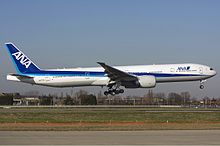
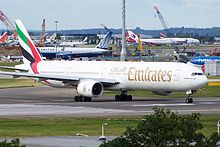
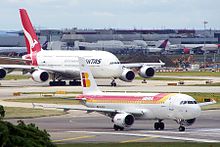

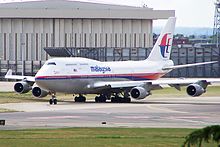
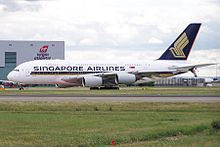
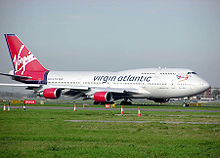
Passenger
| Airlines | Destinations | Terminal |
|---|---|---|
| Aegean Airlines | Athens | 1 |
| Aer Lingus | Belfast-City, Cork, Dublin, Shannon | 1 |
| Aeroflot | Moscow-Sheremetyevo | 4 |
| Aeroméxico | Mexico City | 4 |
| Air Algérie | Algiers | 4 |
| Air Astana | Almaty | 4 |
| Air Canada | Calgary, Edmonton, Halifax, Montréal-Trudeau, Ottawa, Toronto-Pearson, Vancouver Seasonal: St. John's |
3 |
| Air China | Beijing-Capital | 3 |
| Air France | Paris-Charles de Gaulle | 4 |
| Air India | Delhi, Mumbai | 4 |
| Air Malta | Malta | 4 |
| Air Mauritius | Mauritius | 4 |
| Air New Zealand | Auckland, Los Angeles | 1 |
| Alitalia | Milan-Linate, Rome-Fiumicino | 4 |
| All Nippon Airways | Tokyo-Narita | 3 |
| American Airlines | Chicago-O'Hare, Dallas/Fort Worth, Los Angeles, Miami, New York-JFK, Raleigh/Durham | 3 |
| Arik Air | Lagos | 4 |
| Asiana Airlines | Seoul-Incheon | 1 |
| Austrian Airlines operated by Tyrolean Airways |
Vienna | 1 |
| Azerbaijan Airlines | Baku | 4 |
| Biman Bangladesh Airlines | Dhaka, Sylhet | 4 |
| British Airways | Amman-Queen Alia, Baku, Beirut, Belfast-City, Cairo, Dublin, Hanover, Luxembourg, Lyon, Marseille, Rotterdam, Tel Aviv-Ben Gurion | 1 |
| British Airways | Bangkok-Suvarnabhumi, Bucharest, Budapest, Gibraltar, Helsinki, Lisbon, Prague, Vienna, Warsaw-Chopin | 3 |
| British Airways | Aberdeen, Abu Dhabi, Abuja, Accra, Agadir, Alicante, Almaty, Amsterdam, Athens, Atlanta, Bahrain, Baltimore, Bangalore, Barcelona, Basel/Mulhouse, Beijing-Capital, Bergen, Berlin-Tegel, Bologna, Boston, Brussels, Buenos Aires-Ezeiza, Calgary, Cape Town, Chengdu (begins 22 September 2013), Chennai, Chicago-O'Hare, Copenhagen, Dallas/Fort Worth, Delhi, Denver, Doha, Dubai, Düsseldorf, Edinburgh, Entebbe, Frankfurt, Freetown, Geneva, Glasgow-International, Gothenburg-Landvetter, Grand Cayman, Hamburg, Hong Kong, Houston-Intercontinental, Hyderabad, Ibiza (begins 27 April 2013), Istanbul-Atatürk, Jeddah, Johannesburg-Tambo, Kiev-Boryspil, Kuwait, Lagos, Larnaca, Las Vegas, Leeds/Bradford, Los Angeles, Luanda, Lusaka, Madrid, Manchester, Marrakech, Mexico City, Miami, Milan-Linate, Milan-Malpensa, Monrovia, Montreal-Trudeau, Moscow-Domodedovo, Mumbai, Munich, Muscat, Nairobi, Nassau, New York-JFK, Newark, Newcastle upon Tyne, Nice, Oslo-Gardermoen, Palma de Mallorca, Paris-Charles de Gaulle, Paris-Orly, Philadelphia, Phoenix, Pisa, Providenciales, Rio de Janeiro-Galeão, Riyadh, Rome-Fiumicino, St. Petersburg, San Diego, San Francisco, São Paulo-Guarulhos, Seattle/Tacoma, Seoul-Incheon, Shanghai-Pudong, Singapore, Sofia, Stavanger, Stockholm-Arlanda, Stuttgart, Sydney, Tokyo-Haneda, Tokyo-Narita, Toronto-Pearson, Toulouse, Tripoli, Vancouver, Venice-Marco Polo, Washington-Dulles, Zagreb, Zürich | 5 |
| Brussels Airlines | Brussels | 1 |
| Bulgaria Air | Sofia | 4 |
| Cathay Pacific | Hong Kong | 3 |
| China Eastern Airlines | Shanghai-Pudong | 4 |
| China Southern Airlines | Guangzhou | 4 |
| Croatia Airlines | Zagreb Seasonal: Rijeka, Split |
1 |
| Cyprus Airways | Larnaca | 1 |
| Delta Air Lines | Atlanta, Boston, Detroit, Minneapolis/St. Paul, New York-JFK | 4 |
| EgyptAir | Cairo, Luxor | 3 |
| El Al | Tel Aviv-Ben Gurion | 1 |
| Emirates | Dubai | 3 |
| Ethiopian Airlines | Addis Ababa | 3 |
| Etihad Airways | Abu Dhabi | 4 |
| EVA Air | Bangkok-Suvarnabhumi, Taipei-Taoyuan | 3 |
| Finnair | Helsinki | 3 |
| Germanwings | Cologne/Bonn, Stuttgart | 1 |
| Gulf Air | Bahrain | 4 |
| Iberia | Madrid | 5 |
| Icelandair | Reykjavík-Keflavík | 1 |
| Iran Air | Tehran-Imam Khomeini | 3 |
| Japan Airlines | Tokyo-Narita | 3 |
| Jat Airways | Belgrade | 4 |
| Jet Airways | Delhi, Mumbai | 4 |
| Kenya Airways | Nairobi | 4 |
| KLM | Amsterdam | 4 |
| KLM operated by KLM Cityhopper |
Amsterdam | 4 |
| Korean Air | Seoul-Incheon | 4 |
| Kuwait Airways | Kuwait, New York-JFK | 4 |
| Libyan Airlines | Tripoli | 3 |
| LOT Polish Airlines | Warsaw-Chopin | 1 |
| Lufthansa | Berlin-Tegel, Düsseldorf, Frankfurt, Hamburg, Munich | 1 |
| Malaysia Airlines | Kuala Lumpur | 4 |
| Middle East Airlines | Beirut | 3 |
| Oman Air | Muscat | 3 |
| Pakistan International Airlines | Islamabad, Karachi, Lahore | 3 |
| Qantas | Dubai, Melbourne, Sydney | 3 |
| Qatar Airways | Doha | 4 |
| Royal Air Maroc | Casablanca, Marrakech, Tangier | 4 |
| Royal Brunei Airlines | Bandar Seri Begawan, Dubai | 4 |
| Royal Jordanian | Amman-Queen Alia | 3 |
| Saudia | Jeddah, Riyadh | 4 |
| Scandinavian Airlines | Copenhagen, Gothenburg-Landvetter, Oslo-Gardermoen, Stavanger, Stockholm-Arlanda | 3 |
| Singapore Airlines | Singapore | 3 |
| South African Airways | Johannesburg | 1 |
| SriLankan Airlines | Colombo | 4 |
| Swiss International Air Lines | Geneva, Zürich | 1 |
| TAM Airlines | Rio de Janeiro-Galeão, São Paulo-Guarulhos | 1 |
| TAP Portugal | Lisbon Seasonal: Funchal |
1 |
| TAROM | Bucharest, Iași (begins 27 April 2013) | 4 |
| Thai Airways International | Bangkok-Suvarnabhumi | 3 |
| Transaero Airlines | Moscow-Vnukovo | 1 |
| Tunisair | Tunis | 4 |
| Turkish Airlines | Istanbul-Atatürk | 3 |
| Turkmenistan Airlines | Ashgabat | 3 |
| United Airlines | Chicago-O'Hare, Los Angeles, San Francisco, Washington-Dulles | 1 |
| United Airlines | Houston-Intercontinental, Newark | 4 |
| US Airways | Charlotte, Philadelphia | 1 |
| Uzbekistan Airways | Tashkent | 4 |
| Virgin Atlantic Airways | Accra, Boston, Delhi, Dubai, Hong Kong, Johannesburg-Tambo, Lagos, Los Angeles, Miami, Mumbai, New York-JFK, Newark, San Francisco, Shanghai-Pudong, Sydney, Tokyo-Narita, Washington-Dulles Seasonal: Cape Town, Chicago-O'Hare, Vancouver |
3 |
| Virgin Atlantic Little Red operated by Aer Lingus |
Aberdeen (begins 9 April 2013), Edinburgh (begins 5 April 2013), Manchester | 1 |
| Vueling | A Coruña, Bilbao, Florence, Palma de Mallorca | 3 |
Terminal moves and rearrangements
Following the opening of Terminal 5 in March 2008, a hugely complex programme of terminal moves has been implemented. This has seen many airlines move so as to be grouped in terminals by airline alliance as far as possible. However, the process was complicated by the acquisition of Star Alliance member BMI by Oneworld member British Airways, the transfer of Continental Airlines from SkyTeam to Star Alliance prior to its merger with United Airlines, and formerly non-aligned carriers such as EVA Air and Malaysia Airlines joining alliances. As of January 2013, the terminals are assigned to airline alliances as follows:
- Terminal 1: Star Alliance, with some British Airways destinations
- Terminal 3: Oneworld and Star Alliance as well as Virgin Atlantic
- Terminal 4: SkyTeam, with some United Airlines destinations
- Terminal 5: Oneworld (British Airways and Iberia)
Non-aligned airlines operate from Terminals 1, 3 and 4. Virgin Atlantic's domestic flights operate from Terminal 1.
When Phase 1 of the new Terminal 2 opens (expected to be in January 2014), all Star Alliance member airlines will move there (along with Aer Lingus and Virgin Atlantic domestic flights). All British Airways services will be moved to Terminals 3 and 5. Terminal 1 will then be gradually demolished to make way for Phase 2 of the new Terminal 2, with all airlines currently operating from Terminal 1 moving to other terminals. Phase 2 is expected to be completed in early 2019, enabling further moves to relieve pressure on Terminal 3.
Once the moves are complete the terminal assignments are expected to be as follows:
- Terminal 2: Star Alliance, plus Aer Lingus and Virgin Atlantic's domestic operations
- Terminal 3: Oneworld (including some British Airways flights), Virgin Atlantic long-haul and some non-aligned airlines
- Terminal 4: SkyTeam, plus most non-aligned airlines
- Terminal 5: IAG - (most British Airways flights, except those at Terminal 3, and Iberia)
Cargo
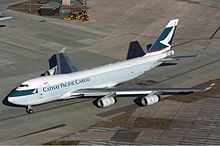
| Airlines | Destinations |
|---|---|
| British Airways World Cargo | Abu Dhabi, Amsterdam, Atlanta, Bangkok-Suvarnabhumi, Beijing-Capital, Brussels, Budapest, Cairo, Chennai, Chicago-O'Hare, Dallas/Fort Worth, Delhi, Dubai, Frankfurt, Glasgow-Prestwick, Hong Kong, Johannesburg, Manchester (UK), Mexico City, Milan-Malpensa, Moscow-Sheremetyevo, Mumbai, Paris-Charles de Gaulle, São Paulo-Guarulhos, Seoul-Incheon, Singapore, Sofia, Sydney, Taipei-Taoyuan, Toronto-Pearson |
| Cathay Pacific Cargo | Delhi, Hong Kong, Milan-Malpensa, Paris-Charles de Gaulle |
| DHL | Amsterdam, Brussels, East Midlands, Frankfurt, Madrid, Paris-Charles de Gaulle |
| Emirates SkyCargo | Dubai |
| Etihad Crystal Cargo | Abu Dhabi, Frankfurt |
| EVA Air Cargo | Bangkok-Suvarnabhumi, Dubai, Taipei-Taoyuan |
| Korean Air Cargo | Seoul-Incheon |
| MASkargo | Kuala Lumpur |
| Royal Air Maroc Cargo | Casablanca |
| Royal Jordanian Cargo | Amman-Queen Alia |
| Singapore Airlines Cargo | Copenhagen, Sharjah, Singapore |
| Swiss WorldCargo | Zürich |
Other facilities
The head office of BAA Limited is located in the Compass Centre by Heathrow's northern runway, a building that previously served as a British Airways flight crew centre. The World Business Centre Heathrow consists of buildings one and two. 1 World Business Centre houses offices of BAA Limited, Heathrow Airport, and Scandinavian Airlines. International Airlines Group has its head office in 2 World Business Centre.
At one time the British Airways head office was located within Heathrow Airport at Speedbird House before the completion of Waterside, the current BA head office in Harmondsworth, in June 1998.
To the north of the airfield lies the Northern Perimeter Road, along which most of Heathrow’s car rental agencies are based, and Bath Road, which runs parallel to it, but outside the airport campus - this is nicknamed by locals as “The Strip” owing to its continuous line of airport hotels.
Traffic and statistics
Although BAA claims that Heathrow is the "world's busiest international airport", in 2011 it ranked third-busiest by total passenger traffic, after Atlanta and Beijing which are both international airports. However, Heathrow does have the highest number of international passengers.
In 2011, Heathrow was the busiest airport in Europe in terms of total passenger traffic, with 13.9% more passengers than Paris-Charles de Gaulle Airport and 23.0% more than Frankfurt Airport, However, it was in second place behind Charles de Gaulle in terms of total aircraft movements in 2011 with 5.1% fewer landings and take offs than its French counterpart. Heathrow was the third busiest European airport by cargo traffic in 2010, after Paris Charles de Gaulle and Frankfurt.
Annual passenger numbers
|
|
handled |
% Change |
(tonnes) |
% Change |
Movements |
% Change |
|---|---|---|---|---|---|---|
| 1986 | 31,675,779 | 537,131 | 315,753 | |||
| 1987 | 35,079,755 | 574,116 | 329,977 | |||
| 1988 | 37,840,503 | 642,147 | 351,592 | |||
| 1989 | 39,881,922 | 686,170 | 368,429 | |||
| 1990 | 42,950,512 | 695,347 | 390,372 | |||
| 1991 | 40,494,575 | 654,625 | 381,724 | |||
| 1992 | 45,242,591 | 754,770 | 406,481 | |||
| 1993 | 47,899,081 | 846,486 | 411,173 | |||
| 1994 | 51,713,366 | 962,738 | 424,557 | |||
| 1995 | 54,461,597 | 1,031,639 | 434,525 | |||
| 1996 | 56,049,706 | 1,040,486 | 440,343 | |||
| 1997 | 58,185,398 | 1,156,104 | 440,631 | |||
| 1998 | 60,683,988 | 1,208,893 | 451,382 | |||
| 1999 | 62,268,292 | 1,265,495 | 458,300 | |||
| 2000 | 64,618,254 | 1,306,905 | 466,799 | |||
| 2001 | 60,764,924 | 1,180,306 | 463,567 | |||
| 2002 | 63,362,097 | 1,234,940 | 466,545 | |||
| 2003 | 63,495,367 | 1,223,439 | 463,650 | |||
| 2004 | 67,342,743 | 1,325,173 | 476,001 | |||
| 2005 | 67,913,153 | 1,305,686 | 477,887 | |||
| 2006 | 67,527,923 | 1,264,129 | 477,048 | |||
| 2007 | 68,066,028 | 1,310,987 | 481,476 | |||
| 2008 | 67,054,745 | 1,397,054 | 478,693 | |||
| 2009 | 66,036,957 | 1,277,650 | 466,393 | |||
| 2010 | 65,881,660 | 1,472,988 | 454,823 | |||
| 2011 | 69,433,230 | 1,484,351 | 480,906 | |||
| 2012 | 70,037,417 | 1,464,390 | 475,176 |
Busiest international routes
|
(2010) |
|
(2011) |
(2010) |
2010 / 11 |
(2009) |
2009 / 10 |
|---|---|---|---|---|---|---|
| 1 (1) | 2,678,991 | 2,517,896 | 2,478,722 | |||
| 2 (2) | 1,889,513 | 1,787,561 | 1,745,005 | |||
| 3 (3) | 1,556,102 | 1,493,613 | 1,604,044 | |||
| 4 (7) | 1,469,904 | 1,266,240 | 1,201,354 | |||
| 5 (4) | 1,412,749 | 1,386,779 | 1,528,886 | |||
| 6 (5) | 1,407,083 | 1,333,124 | 1,509,787 | |||
| 7 (8) | 1,299,118 | 1,189,309 | 1,235,549 | |||
| 8 (6) | 1,272,349 | 1,299,701 | 1,338,307 | |||
| 9 (9) | 1,207,424 | 1,138,012 | 1,218,516 | |||
| 10 (11) | 1,197,847 | 1,091,818 | 1,003,041 | |||
| 11 (10) | 1,191,170 | 1,093,538 | 1,127,369 | |||
| 12 (14) | 1,090,279 | 975,465 | 907,897 | |||
| 13 (13) | 1,069,706 | 1,022,220 | 1,123,503 | |||
| 14 (12) | 1,052,936 | 1,032,872 | 945,369 | |||
| 15 (23) | 1,030,867 | 866,719 | 850,620 | |||
| 16 (18) | 1,003,598 | 918,196 | 756,013 | |||
| 17 (17) | 989,045 | 920,514 | 1,001,468 | |||
| 18 (25) | 977,906 | 859,143 | 640,131 | |||
| 19 (21) | 958 247 | 876,385 | 888,246 | |||
| 20 (27) | 953,878 | 822,315 | 846,211 | |||
| 21 (15) | 950,819 | 957,439 | 861,667 | |||
| 22 (22) | 939,197 | 870,072 | 853,849 | |||
| 23 (16) | 926,239 | 940,448 | 1,013,477 | |||
| 24 (24) | 925,722 | 860,617 | 892,735 | |||
| 25 (19) | 889,631 | 912,362 | 891,493 | |||
| 26 (26) | 847,936 | 725,017 | 653,169 | |||
| 27 (20) | 840,184 | 886,146 | 921,194 | |||
| 28 (29) | 778,612 | 731,100 | 649,007 | |||
| 29 (30) | 745,611 | 727,335 | 697,460 | |||
| 30 (28) | 735,414 | 784,308 | 666,171 | |||
| 31 (33) | 733,761 | 647,636 | 599,415 | |||
| 32 (35) | 710,101 | 605,989 | 725,005 | |||
| 33 (31) | 698,036 | 696,301 | 741,583 | |||
| 34 (37) | 694,503 | 596,543 | 513,659 | |||
| 35 (34) | 681,034 | 640,782 | 583,380 | |||
| 36 (38) | 626,860 | 592,477 | 610,700 | |||
| 37 (32) | 604,045 | 683,186 | 753,997 | |||
| 38 (NEW) | 603,881 | 541,152 | 525,690 | |||
| 39 (39) | 591,919 | 578,543 | 560,235 | |||
| 40 (36) | 579,002 | 597,826 | 599,574 | |||
| Total | 39,249,091 | 38,055,601 | 37,737,808 |
Busiest domestic routes
|
(2010) |
|
(2011) |
(2010) |
2010 / 11 |
|---|---|---|---|---|
| 1 (1) | Edinburgh | 1,271,459 | 1,244,793 | |
| 2 (2) | Glasgow-International | 820,949 | 1,003,344 | |
| 3 (3) | Manchester | 766,906 | 799,264 | |
| 4 (4) | Aberdeen | 652,520 | 617,693 | |
| 5 (6) | Newcastle | 473,614 | 424,251 | |
| 6 (5) | Belfast-City | 428,611 | 467,826 | |
| 7 (7) | Belfast-International | 289,359 | 284,029 | |
| Total Domestic | 4,702,811 | 4,840,832 |
Countries with most passengers to Heathrow
|
|
|
|
2009 / 10 |
|---|---|---|---|
| 1 | 12,340,933 | ||
| 2 | 4,341,214 | ||
| 3 | 2,377,026 | ||
| 4 | 2,354,965 | ||
| 5 | 2,291,338 | ||
| 6 | 2,283,731 | ||
| 7 | 2,156,503 | ||
| 8 | 2,138,519 | ||
| 9 | 2,127,872 | ||
| 10 | 1,896,859 | ||
| 11 | 1,386,779 | ||
| 12 | 1,378,268 | ||
| 13 | 1,333,124 | ||
| 14 | 1,058,134 | ||
| 15 | 1,046,910 | ||
| 16 | 1,030,619 | ||
| 17 | 1,022,220 | ||
| 18 | 870,104 | ||
| 19 | 747,425 | ||
| 20 | 746,946 |
Access
Public transport
Train
- Heathrow Express: a non-stop service directly to London's Paddington station; trains leave every 15 minutes for the 15-minute journey (21 minutes to/from Terminal 5). Trains depart from Heathrow Terminal 5 station or Heathrow Central station (Terminals 1 & 3). A Heathrow Express transfer service operates between Terminal 4 and Heathrow Central to connect with services from London and Terminal 5.
- Heathrow Connect: a stopping service to Paddington calling at up to five National Rail stations en route – trains leave every 30 minutes for the 27-minute journey. Heathrow Connect services terminate at Heathrow Central station (Terminals 1 & 3).
- London Underground Piccadilly line: four tube stations serve the airport – Terminals 1, 2, 3; Terminal 4; Terminal 5 serves the passenger terminals, and Hatton Cross the maintenance areas. The standard journey time from Heathrow Terminals 1 & 3 tube station to Central London is around 40–50 minutes.
- South West Trains has a direct bus transfer to Feltham railway station, allowing passengers to change services towards Reading and Windsor or Clapham Junction and Waterloo Station.
Bus and coach
Many buses and coaches operate from the large Heathrow airport central bus station serving Terminals 1 and 3, and also from bus stations at Terminals 4 and 5. Services include the following:
- Long-distance coach services operated by National Express and Oxford Bus Company to various parts of the UK, including Victoria Coach Station in London
- HotelHoppa buses connect each terminal with hotels in the Heathrow area
- There are two RailAir coach services connecting nearby railway stations with the airport using dedicated non-stop coaches and running to:
- Reading railway station, connecting with railway services to the West Country, South Wales, Midlands, the North of England and the south coast of England
- Woking railway station, for destinations in Surrey, Hampshire, Dorset and Wiltshire
- A connection to Feltham railway station, for Richmond, Camberley, Bracknell, London Waterloo and Clapham Junction, using London Buses route 285 ( route 490 from Terminals 4 and 5)
- Express bus services to Watford, St Albans and Harlow ( Green Line route 724), Croydon ( London Buses route X26) and High Wycombe ( Carousel Buses)
- Local bus services by London Buses, First Berkshire & The Thames Valley and other companies to nearby towns and London suburbs
- Night bus N9 operates to central London at night when the trains do not operate
Between 1981 and 2004, the airport was linked to central London by a group of routes known as Airbus. These routes carried A prefixes before their numbers; one route, A10, operates with such a number to Uxbridge.
Inter-terminal transport
Terminals 1 and 3 are within walking distance of each other. Transfers to Terminal 4 & 5 are by Heathrow Express trains or bus. Heathrow Express and Heathrow Connect services between Heathrow Central and Terminals 4 and 5 are free of charge. Normal fare rules apply to London Underground services between terminals. Local buses throughout the airport area are provided free of charge under the "Heathrow FreeFlow" scheme; passengers should tell the driver their destination to ensure they are not charged a fare.
Transit passengers remaining airside are provided free dedicated transfer buses between terminals.
ULTra Personal Rapid Transport has been opened in April 2011 to shuttle passengers to and from Terminal 5 at a speed of up to 40 km/h (25 mph). The initial trial will have 18 pods running. ULTra are small transportation pods that can fit four adults, two children, and their luggage and will be able to carry passengers directly to the terminal. The pods are battery powered and will be initially used on a four kilometre track. If the trial is successful there are plans for a roll out airport-wide. The capsules run on demand. The provider claims a 95% availability rate and no accidents so far.
Taxi
Taxis are available at all terminals.
Car
Heathrow is accessible via the nearby M4 motorway and A4 road (Terminals 1–3), the M25 motorway (Terminals 4 and 5), and the A30 road (Terminal 4). There are drop off and pick up areas at all terminals and short and long stay multi-storey car parks. Additionally, there are car parks not run by BAA just outside the airport, the most recognisable is the National Car Parks facility although there are many other options; these car parks are connected to the terminals by shuttle buses.
Four parallel tunnels under one of the runways connect the M4 motorway and the A4 road to Terminals 1–3. The two larger tunnels are each two lanes wide and are used for motorised traffic. The two smaller tunnels were originally reserved for pedestrians and bicycles; to increase traffic capacity the cycle lanes have been modified to each take a single lane of cars, although bicycles still have priority over cars. Pedestrian access to the smaller tunnels has been discontinued, with the free bus services being the alternative.
Bicycle
There are (mainly off-road) bicycle routes to some of the terminals. Free bicycle parking places are available in car parks 1 and 1A, at Terminal 4, and to the North and South of Terminal 5's Interchange Plaza.
Accidents and incidents
- On 3 March 1948, Sabena Douglas DC3 Dakota OO-AWH crashed in fog. Three crew and 19 of the 22 passengers onboard died.
- On 31 October 1950, BEA Vickers Viking G-AHPN crashed at Heathrow after hitting the runway during a go-around. Three crew and 25 passengers died.
- On 1 August 1956, XA897, an Avro Vulcan strategic bomber of the Royal Air Force, crashed at Heathrow after an approach in bad weather. The Vulcan was the first to be delivered to the RAF, and was returning from a demonstration flight to Australia and New Zealand. The pilot and co-pilot ejected and survived, but the four other occupants were killed.
- On 7 January 1960, Vickers Viscount G-AOHU of BEA was damaged beyond economic repair when the nose wheel collapsed on landing. A fire then developed and burnt out the fuselage. There were no casualties among the 59 people on board.
- On 27 October 1965, BEA Vickers Vanguard G-APEE, flying from Edinburgh, crashed on Runway 28R while attempting to land in poor visibility. All 30 passengers and six crew onboard died.
- On 8 April 1968, BOAC Flight 712 Boeing 707 G-ARWE, departing for Australia via Singapore, suffered an engine fire just after take-off. The engine fell from the wing into a nearby gravel pit in Staines-upon-Thames, before the plane managed to perform an emergency landing with the wing on fire. However, the plane was consumed by fire once on the ground. Five people; four passengers and a stewardess – died, while 122 survived. Barbara Harrison, a flight attendant on board who helped with the evacuation, was posthumously awarded the George Cross.
- On 3 July 1968, the port flap operating rod of G-AMAD, an Airspeed Ambassador operated by BKS Air Transport failed due to fatigue thereby allowing the port flaps to retract. This resulted in a rolling moment to port which could not be controlled during the approach, causing the aircraft to contact the grass and swerve towards the terminal building. It hit two parked British European Airways Hawker Siddeley Trident aircraft, burst into flames and came to rest against the ground floor of the terminal building. Six of the eight crew died, as did eight horses on board. Trident G-ARPT was written off, and Trident G-ARPI was badly damaged, but subsequently repaired, only to be lost in the Staines crash in 1972.
- On 22 January 1970, Vickers Viscount G-AWXI of British Midland was damaged beyond economic repair when an engine caught fire on take-off. A successful emergency landing was made at Heathrow.
- On 18 June 1972, Trident G-ARPI, operating as BEA548, crashed in a field close to the Crooked Billet Public House, Staines, two minutes after taking off. All 118 passengers and crew on board died.
- On 5 November 1997, a Virgin Atlantic Airbus A340-300, G-VSKY, made an emergency landing following an undercarriage malfunction. Part of the undercarriage collapsed on landing, and both aircraft and runway were damaged. Recommendations made as a result of the accident included one that aircraft cabin door simulators should more accurately reproduce operating characteristics in an emergency, and another that cockpit voice recorders should have a two-hour duration in aircraft registered before April 1998.
- On 17 January 2008, a British Airways Boeing 777-236ER, G-YMMM, operating flight BA038 from Beijing, crash-landed at Heathrow. The aircraft landed on grass short of the south runway, then slid to the edge of the runway and stopped on the threshold, leading to eighteen minor injuries. The aircraft was later found to have suffered loss of thrust caused by fuel icing.
Terrorism and security incidents
- On 8 June 1968, James Earl Ray, the man convicted of the assassination of Martin Luther King, Jr., was captured and arrested at Heathrow Airport while attempting to leave the United Kingdom on a false Canadian passport.
- On 19 May 1974, the IRA planted a series of bombs in the Terminal 1 car park. Two people were injured by the explosions.
- On 26 November 1983, the Brink's-MAT robbery occurred, in which 6,800 gold bars worth nearly £26 million were taken from a vault near Heathrow. Only a small amount of the gold was recovered, and only two men were convicted of the crime.
- On 17 April 1986, semtex explosives were found in the bag of a pregnant Irishwoman attempting to board an El Al flight. The explosives had been given to her by her Jordanian boyfriend and father of her unborn child Nizar Hindawi. The incident became known as the Hindawi Affair.
- On 21 December 1988, Pan Am Flight 103 from Heathrow to New York/JFK was blown up over Lockerbie, Scotland, killing all 259 onboard and 11 other people on the ground.
- In 1994, over a six-day period, Heathrow was targeted three times (8, 10, and 13 March) by the IRA, which fired 12 mortars. Heathrow was a symbolic target due to its importance to the UK economy, and much disruption was caused when areas of the airport were closed over the period. The gravity of the incident was heightened by the fact that the Queen was being flown back to Heathrow by the RAF on 10 March.
- In March 2002, thieves stole US$3 million that had arrived on a South African Airways flight.
- In February 2003, the British Army was deployed to Heathrow along with 1,000 police officers in response to intelligence reports suggesting that al-Qaeda terrorists might launch surface-to-air missile attacks at British or American airliners.
- On 17 May 2004, Scotland Yard's Flying Squad foiled an attempt by seven men to steal £40 million in gold bullion and a similar quantity of cash from the Swissport warehouse at Heathrow.
- On 10 August 2006, the airport became the focus of changes in security protocol, following the revelation of a supposed al-Qaeda terrorist plot. New security rules were put in force immediately, causing additional restrictions in regards to carrying liquids onto flights. This caused longer queues and wait times at security. These included the prohibition of carry-on luggage (except essential items such as travel documents and medication) and all liquids – although this rule was later relaxed to allow the carrying onboard of liquid medications and baby milk, if they were tasted first by passengers at the security checkpoint.
- On 25 February 2008, Greenpeace activists protesting against the planned third runway managed to cross the tarmac and climb atop a British Airways Airbus A320, which had just arrived from Manchester Airport. At about 09:45 GMT the protesters unveiled a banner, saying "Climate Emergency – No Third Runway", over the aircraft's tailfin. By 11:00 GMT four arrests had been made.
- On 13 March 2008, a man with a rucksack scaled the perimeter fence onto runway 27R, and ran across the grounds, resulting in his subsequent arrest. A controlled explosion of his bag took place, although nothing suspicious was found, and the Metropolitan Police later said that the incident had not been terrorism related.
Other incidents
- Flights from Heathrow were suspended from midday Thursday 15 April 2010 to 22:00 Tuesday 20 April 2010 due to risk of jet engines being damaged by volcanic ash in the upper atmosphere caused by the eruption of Eyjafjallajökull in Iceland.
- On 18 December 2010, 'heavy' (9 cm, according to the Heathrow Winter Resilience Enquiry) snowfall caused the closure of the entire airport, causing one of the largest incidents at Heathrow of all time. 4,000 flights were cancelled over five days and 9,500 passengers spent the night at Heathrow on 18 December following the initial snowfall. The problems were caused not only by snow on the runways, but also by snow and ice on the 198 parking stands which were all occupied by aircraft.
Future expansion
Runway and terminal expansion
In January 2009 the Transport Secretary Geoff Hoon announced that the UK government supported the expansion of Heathrow by building a third 2,200-metre (7,200 ft) runway and a sixth terminal building. This decision followed the 2003 white paper on the future of air transport in the UK, and a public consultation in November 2007. This was a controversial decision which met with widespread opposition because of the expected greenhouse gas emissions, impact on local communities, as well as noise and air pollution concerns.
Before the 2010 General Election the Conservative and Liberal Democrats parties announced that they would prevent the construction of any third runway or further material expansion of the airport's operating capacity. The Mayor of London, Boris Johnson, has taken the position that London needs more airport capacity, but favours constructing an entirely new airport in the Thames Estuary rather than expanding Heathrow. After the Conservative – Liberal Democrat coalition took power, it was announced that the third runway expansion was cancelled. Two years later, leading Conservatives were reported to have changed their minds.
Heathrow railway hub
A plan to make Heathrow an international railway exchange has also been proposed with the potential construction of Heathrow Hub railway station, built on a link to the High Speed 2 railway line.
Airtrack
In July 2009, Heathrow Airport Limited submitted an application to the Secretary of State for Transport seeking to gain authorisation to develop a new rail link to Heathrow Terminal 5 to be known as Heathrow Airtrack. The rail link would address the current lack of public transport available to the South West of the Airport by connecting to Guildford, Reading and London Waterloo. BAA stated that the scheme should add significantly to its aim of increasing the proportion of people using public transport to travel to the Airport. In April 2011, BAA announced that it was abandoning the project, citing the unavailability of government subsidy and other priorities for Heathrow, such as linking to Crossrail and HS2.
Heathrow/Gatwick rail link
The Department for Transport is currently studying the possibility of a direct high-speed rail link between Heathrow and Gatwick Airport.
